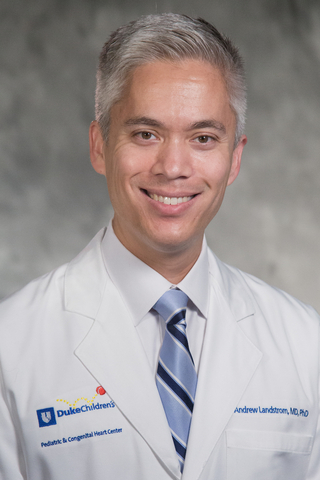Children and young adults presenting with early onset arrhythmia may have high-risk conditions that are managed more effectively at medical centers with research-focused genetic disease programs.
Duke electrophysiologist and pediatric cardiologist Andrew P. Landstrom, MD, PhD, a specialist in heritable arrhythmias, cardiomyopathies, and other genetic cardiac diseases, urges physicians who encounter these presentations in young patients to seek guidance from specialized programs accustomed to involving families in genetic testing and assessment.
“Often these diseases can be life-threatening, and unfortunately, they are typically unknown and undiagnosed,” Landstrom says. “Thankfully, these diagnoses are not rare when the patients can be evaluated at a center with a genetic disease emphasis. We have worked hard to build such a program at Duke, and we can partner with practitioners to help manage the potential risks these conditions present and complications that may arise from genetic testing.”
In addition to working with patients and their families — as these diagnoses sometimes lead to discovering genetic mutations that may affect generations — Landstrom leads research that brings together clinical medicine and functional genomics as well as molecular and cellular biology. He maintains a wet bench research lab where he employs molecular genomics using induced pluripotent stem cells to pinpoint genetic disorders.
“One very exciting tool is using patient-derived stem cells. We can guide these stem cells to become disease heart cells that we can use to test new therapies,” Landstrom explains. “We are literally creating the patient’s heart in a dish in the lab. That puts us in the middle of developing solutions to complex diseases within this community of cardiovascular genetics.” Among these potential solutions are gene therapy approaches which hold promise to revolutionize care in the coming years.

AHA scientific statement promotes genetic testing
Landstrom was the lead author of a 2021 American Heart Association scientific statement encouraging genetic testing in children with arrhythmic conditions; the statement also emphasizes the need for multidisciplinary counseling about timing of tests. The authors also encouraged follow-up care to re-evaluate the pathogenicity of variants and address the changing needs of patients and their families.
The timing of genetic tests for genetic cardiac conditions in children, Landstrom notes, has been a sensitive topic. “There was a misconception that kids should not be tested because most of the time, they do not develop signs of the disease when they are young,” he says. “The logic follows that we should wait until they can give consent. At that point, we can ask if they really want to know about the condition and the risks.”
That practice is evolving, Landstrom says. Because medication and lifestyle changes benefit patients with genetic conditions, early testing is becoming more common. “Unfortunately, we know these symptoms can present in childhood, and sometimes the first symptom is sudden death. This is reflected in the current guideline recommendations to treat children who have genetic risk with medications, even if they do not yet demonstrate evidence of the disease.”
Duke specialists work with patients to develop a family-based therapy plan. “No child is too young,” he adds. “If there are actions we can take to assuage risk, we believe the child and parents should be aware and involved.”
